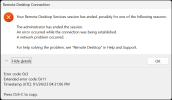frewys
Member
- Messages
- 30
- Reaction score
- 5
Hi
I have been trying to make a minimal media server with no success in getting the remote desktop to work. I get a black screen and the attached error message. I have been looking around for a guide for remote desktop but have had no success.
Mod note: Redacted user passwords & license key.
Thank you for redacting the password license key. I checked through the XML and it looked like it was hidden
I have been trying to make a minimal media server with no success in getting the remote desktop to work. I get a black screen and the attached error message. I have been looking around for a guide for remote desktop but have had no success.
Mod note: Redacted user passwords & license key.
Thank you for redacting the password license key. I checked through the XML and it looked like it was hidden
Attachments
Last edited:

